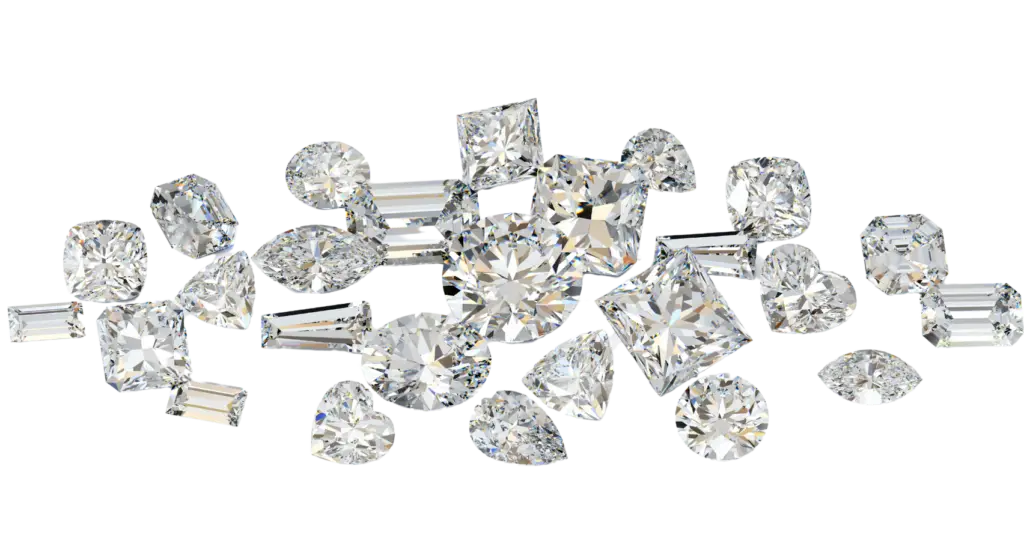Welcome, hi, hello. Lab diamonds? Diamonds in general? Shiny rocks?! Let’s learn…
Okay. So. I’m going to be honest with you. There’s a lot of misinformation floating around when it comes to buying diamonds, and it’s driving me a littttttle bit nuts. Nothing’s worse than someone who got lucky on a diamond purchase and is now walking around giving advice to anyone who will listen (buy the biggest and most expensive! It’ll be perfect! NOPE.) So let’s cut through the BS and break it down in detail… or think of this as the overview before the deep dives.
As always, we are here to help. Reach out and ask questions; we’ve got your back.

1. Buy Returnable When You’re the One Choosing the Stone – Always #
-
Why? Because if the stone isn’t exactly what you expected or something seems off when you see it in person, you need an easy out.
-
The Rule: If you can’t send it back, don’t even think about buying it. There are no exceptions – unless you’re spending money that you can literally afford to lose (and that’s not how you should usually roll).
-
Double-Check Everything: Read the return policies as if your life depended on them. Some places have strict time limits, restocking fees, or hidden conditions. If you’re stuck with a non-returnable stone, you’re setting yourself up for regret.
2. The 4Cs: It’s Not All About Perfection #
We’ve all heard about the 4Cs—cut, color, clarity, and carat—but here’s the lowdown in plain English:
- Cut: Nothing Else Matters if Cut is Off
The cut is what makes a diamond dance with light. If cut right, an SI1 stone can dazzle far above a poorly cut, but higher clarity/color stone. Look for excellent symmetry, polish, and proportions. It’s all about balance: we’re not looking for absolute perfection in every single number because we don’t need to! But we want all of those numbers to work together. We’ll get into it later, promise. - Color & Clarity:
Color: DEFGH in lab stones is colorless. Check the certificate. Does it list a tint where it tells you at the bottom how it’s been treated? No? Great. It’s colorless. Do you want proof?
Do me a favor… these are some stones that I’ve purchased! Can you tell the difference between the G stones and the E stones? No. That’s that sweet, sweet post-growth treatment the natural diamond folks like toraverant about, my friend!!! - Clarity:
You do not need a F/IF stone. Most stones are fully eye-clean down to SI1, even SI2. No, the highest clarity and color grade does not mean the best stone. Don’t get hung up on microscopic imperfections you can’t see without 30x magnification. Those high-clarity grades often come with a premium you don’t need. Don’t believe me? Look at this incredible diamond this user has! It’s an SI1: (unfortunately, we didn’t help her buy it, but it is a really good example!) - Carat: Bigger isn’t always better, and carat “size” actually refers to carat weight. A step-cut stone is going to face up smaller than its carat weight (for example, a five-carat step cut is going to look much smaller than a five-carat radiant because it’s a deep cut). Always check the length mm x width mm to determine the true size of what it will look like.
A slightly smaller, perfectly cut diamond will often outshine a larger one with average proportions. Focus on light return and visual impact over sheer weight.
3. The 5th C: Cost #
We believe diamonds should be about love – for yourself, or someone else – not financial leverage. While lab grown diamonds may not be a strong financial investment, they are an investment in modern values: sustainability, ethics, and individuality. Plus, they’re kinder on your wallet, leaving more room for travel or actual investments – or that anniversary upgrade in five year’s time!
4. Certification and Paperwork: Your Bible of Truth #
Before you commit, get smart about your diamond’s documentation.
- Read the Report:
- Whether it’s from GIA, IGI, or another respected lab, the grading report is your bible. Dive into the plot diagram, check each inclusion noted at 10x magnification, and look for any red flags like treatments or laser drilling (in natural stones)
- Know the Guidelines:
- There are official standards (GIA, IGI) and detailed guides (like the IGI Fancy Shapes Ideals Guide) that break down ideal proportions, symmetry, and more.
- Use these numbers as your roadmap, but don’t be paralyzed by them. Sometimes, a stone’s overall beauty isn’t fully captured by a set of percentages. Trust your gut if the stone lights up your life.
5. Proportions, Bow Ties, and Tweezer Videos #
Ever seen a diamond with a dark “bow tie” effect slicing through it? That’s a proportions issue you want to avoid. There is a lot of fear-mongering online in diamond spaces – the best way to combat that is to see the diamond in real life.
-
-
They will be different for every cut type (brilliant, step, hybrid, and antique) and every shape. Not just that, they’re also going to be different between guides, between retailers, and between diamond cutters and sourcers. We all have a mix of experience buying and evaluating diamonds, and I’ll tell you that we all think our ideals are “best.” But when it comes down to it, the ideals are just that – ideals – NOT gospel. We’re looking for balance.
-
A well-proportioned diamond reflects light evenly. If the proportions are off, even a high-clarity stone can look lackluster.
-
-
Loupe and “Tweezer” Videos:
-
There are two types of videos that we want you to be able to evaluate. The first is a loupe video – a 360 video under extreme magnification. These videos let you see exactly how the stone handles light and where its inclusions are. If you cannot find a 360 video, we suggest using Loupe360. https://loupe360.com/diamond/[YOUR IGI CERT NUMBER HERE] – and an example
-
The second type of video that we want you to be able to see is a “tweezer video” – exactly what it sounds like: a video in real life, under natural lighting conditions, of the stone held by a pair of jewelers’ tweezers. Ideally, we want a couple of videos under different light conditions (shaded sunlight, like indoors by a window), warmer light, and cooler light.
-
6. Trust Your Eye, Not Just the Numbers #
Don’t let the certificate’s numbers blind you to what really matters: how the diamond looks to you.
-
Numbers vs. Real Life:
-
Sure, the grading report gives you the technical details, but nothing beats your own eyes. Many VS or even SI diamonds look flawless once set in jewelry.
-
The true beauty of a diamond is subjective. If a stone captivates you, that’s the ultimate proof it’s the right one.
-
-
Different Cuts, Different Demands:
-
Some cuts—like emerald or Asscher—expose every tiny inclusion, requiring stricter clarity ratings and precise proportions.
-
A well-cut stone can hide minor imperfections in brilliant and hybrid cuts. Trust what you see in person over the dry numbers
-
7. Avoid the Hype and the Scams #
The diamond world is full of hype and scams. Remember, something doesn’t necessarily have to BE a scam to leave you feeling scammed.
Sure, you may buy a cheaply priced diamond and setting, and it may come to your home. But hmm… it’s set in a way that doesn’t feel super professional and clean, and are you SURE this is the diamond that you picked? It’s not necessarily a scam, since you DO have a diamond in your hand, right? But it’s certainly not leaving you feeling good. Please listen to your gut – and this goes back to return policies. At the end of the day, it is your money, and you deserve to feel amazing about your purchase. Speak up, demand better, and if all else fails, get your bank or payment provider involved.
Scam Alerts:
If a deal sounds too good to be true, it probably is. Look up reviews across multiple platforms—forums, Reddit, and trusted blogs. Consistent negative feedback is your cue to walk away.
Community feedback is gold—if many people flag an issue, trust that intuition and move on.
8. Diamonds: For Beauty, Not as Investments #
Let’s get this straight: diamonds aren’t a financial asset.
- Buy for the Sparkle:
- Whether earth-mined or lab-grown, a diamond’s true value lies in its beauty and the joy it brings you—not in some speculative investment portfolio (which, by the way, we encourage! make your money work for you – don’t put it into a diamond expecting a return later)
- Enjoy your diamond for its aesthetic appeal and the story behind its creation—not as a hedge against inflation.
- Realistic Expectations:
- Treat your diamond like a cherished piece of art. It’s meant to make you feel special, not to serve as a speculative asset.
9. Do Your Homework (Seriously) #
Before you make any purchase, research like your future happiness depends on it.
- Research, Research, Research:
- Use search terms like [shape name] diamond + ideal proportions to educate yourself. The more you know, the less likely you are to get taken for a ride. Want a quicker way to do it? Check out ours.
- Dive into trusted forums, watch YouTube reviews, and compare similar stones. Arm yourself with every bit of info you can get.
- Ask for Detailed Information:
- If possible, insist on high-resolution images, detailed videos, and even live demonstrations. If a seller can’t provide clear, detailed info, run.
- Compare stones side by side. Sometimes, a VS1 and an SI1 look virtually identical to the naked eye—and that’s where you can save serious cash without sacrificing quality.
10. Certification, Where, and How to Buy #
This isn’t just about knowing the 4Cs—it’s about buying from the right source and verifying every detail.
- Choose Reputable Sellers:
- Stick with sellers who are transparent about their return policies, have solid reputations, and can back up their certification claims.
- Whether you’re shopping online or in person, do a background check. Look up reviews and get a sense of the seller’s history in the community.
- Verify Every Detail:
- Ensure your diamond comes with a reputable certification report and that every detail matches the stone you’re buying. Discrepancies between the report and the stone are a major red flag.
- Cross-reference the grading report with the seller’s claims. If something doesn’t add up, trust your instincts and move on.
In Conclusion #
We’re here to help you dodge the BS and make a diamond purchase that truly lights up your life. Follow these detailed rules: always buy returnable, focus on a stellar cut, trust your own eyes over the dry numbers, and do your homework as your future self depends on it. There’s a ton of conflicting advice out there, but at the end of the day, it’s all about what makes you happy—both literally and figuratively.
Make good purchases, be kind, and for the love of all that’s shiny, don’t let anyone talk you into bad advice.



